Abstract
1. Endothelium-dependency of vasodilator responses was compared in helical strips of monkey cerebral and superficial temporal arteries contracted with prostaglandin F2 alpha. Acetylcholine produced an endothelium-dependent relaxation in the temporal arteries, but did not consistently alter the tone of cerebral arteries. 2. Adenosine 5'-triphosphate (ATP) produced a transient contraction followed by a relaxation in the temporal and cerebral arteries; removal of the endothelium partially attenuated the relaxation of the cerebral arteries and markedly suppressed the relaxation in the temporal arteries. The dependency of adenosine 5'-diphosphate (ADP)-induced relaxations on the endothelium was also greater in temporal arteries than in cerebral arteries. 3. Histamine-induced relaxations in the temporal arteries were independent of the endothelium and were reversed to contractions by cimetidine. Cerebral arterial relaxations induced by histamine were partly dependent on the endothelium. Relaxations caused by substance P were reversed to contractions by removal of the endothelium in the temporal arteries, whereas the peptide did not consistently alter the tone of cerebral arteries. 4. The Ca2+ ionophore, A23187, relaxed the temporal and cerebral arteries to a similar extent; removal of the endothelium abolished these relaxations. Glyceryl trinitrate elicited similar relaxation of cerebral and temporal arteries, and these were independent of the endothelium. 5. These findings clearly indicate heterogeneity in the endothelium-dependency of several vasodilator responses in monkey intra- and extracranial arteries, although the ability of these arteries to respond to A23187 and glyceryl trinitrate does not appear to differ. The heterogeneous responses observed so far could therefore be due to different distributions of receptors or to variation in receptor-effector coupling in endothelial cells.
Full text
PDF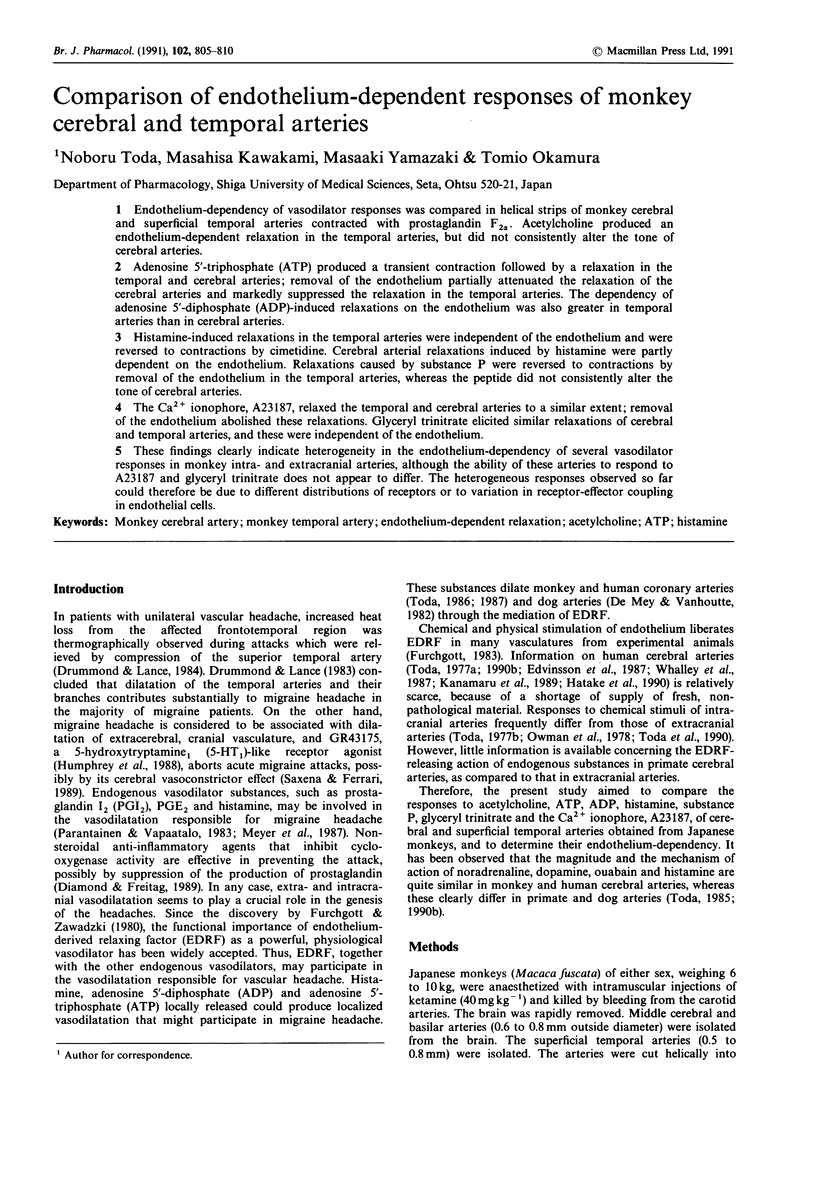
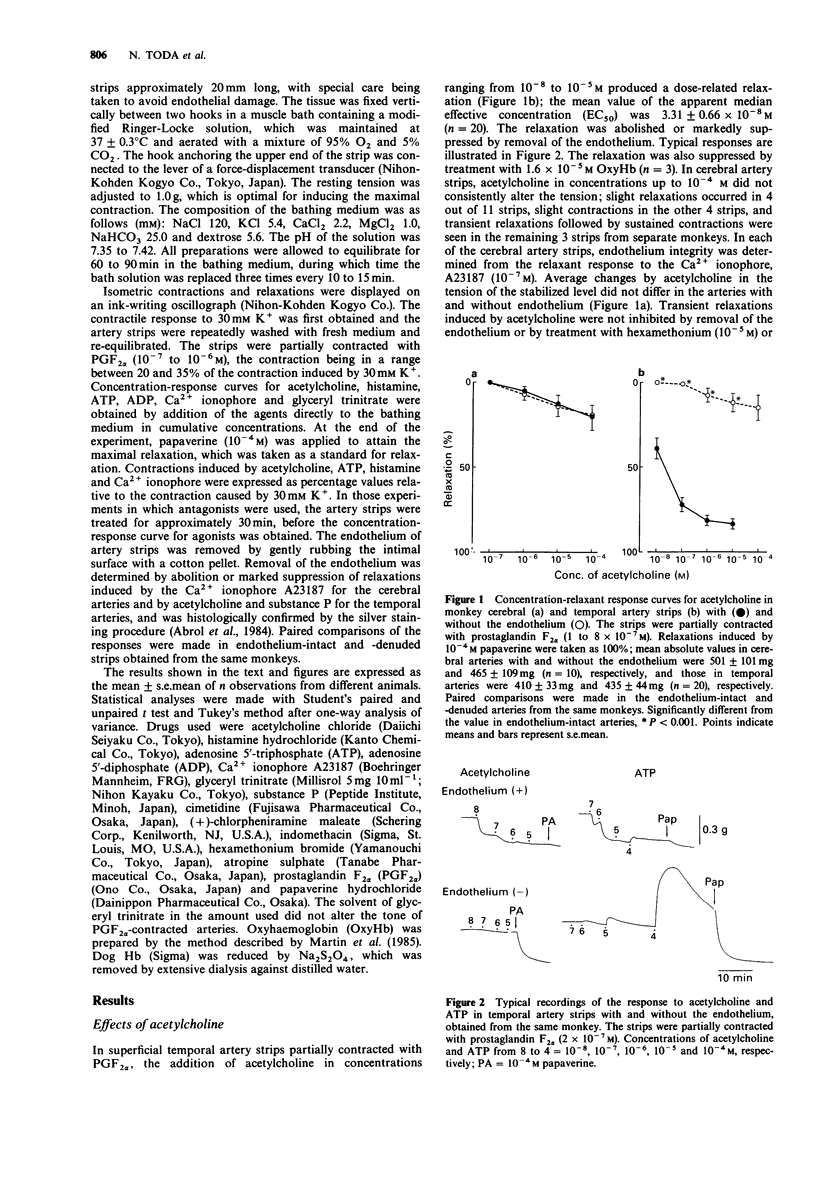
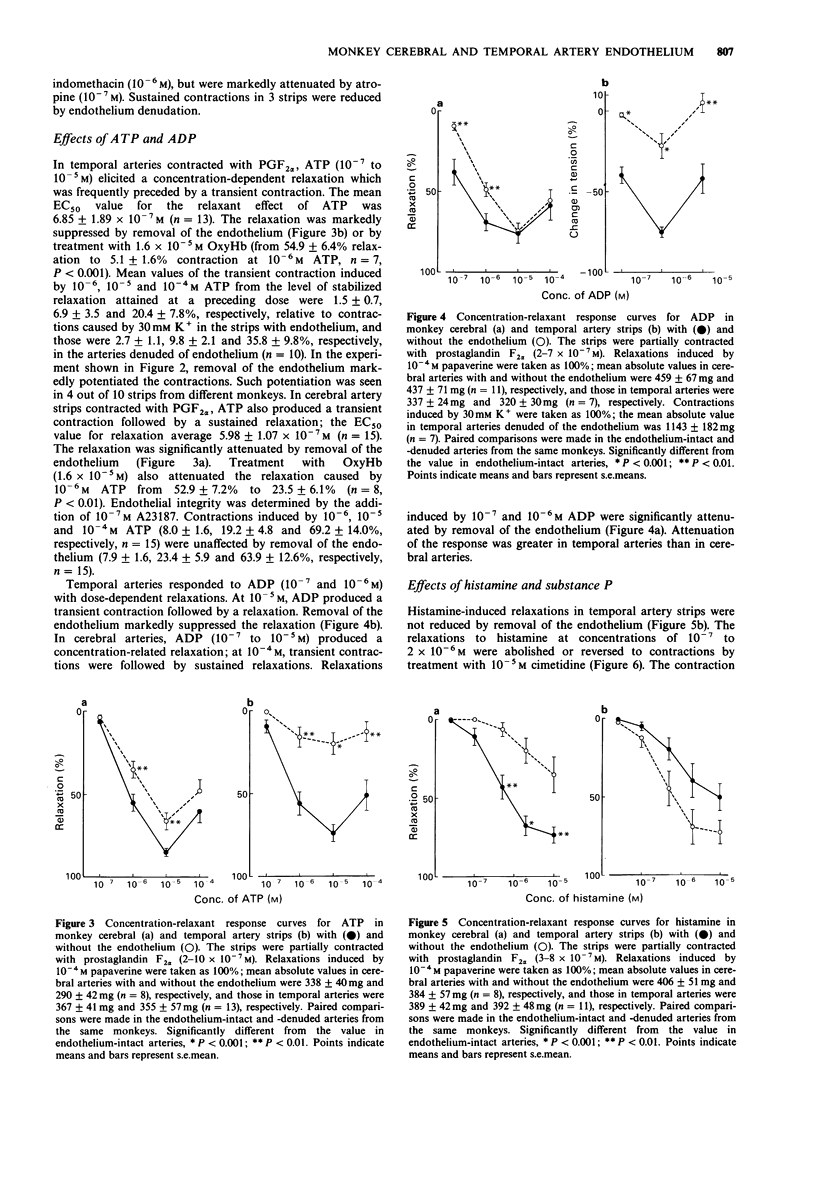
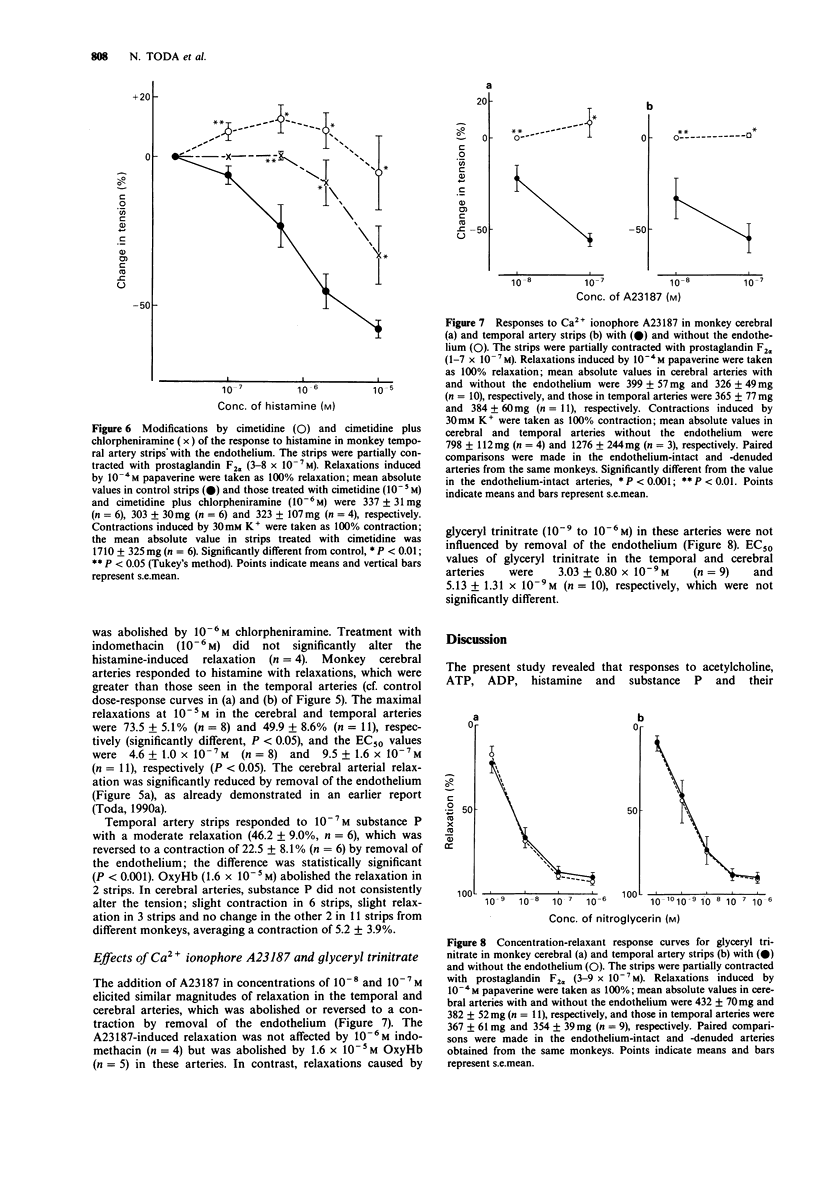
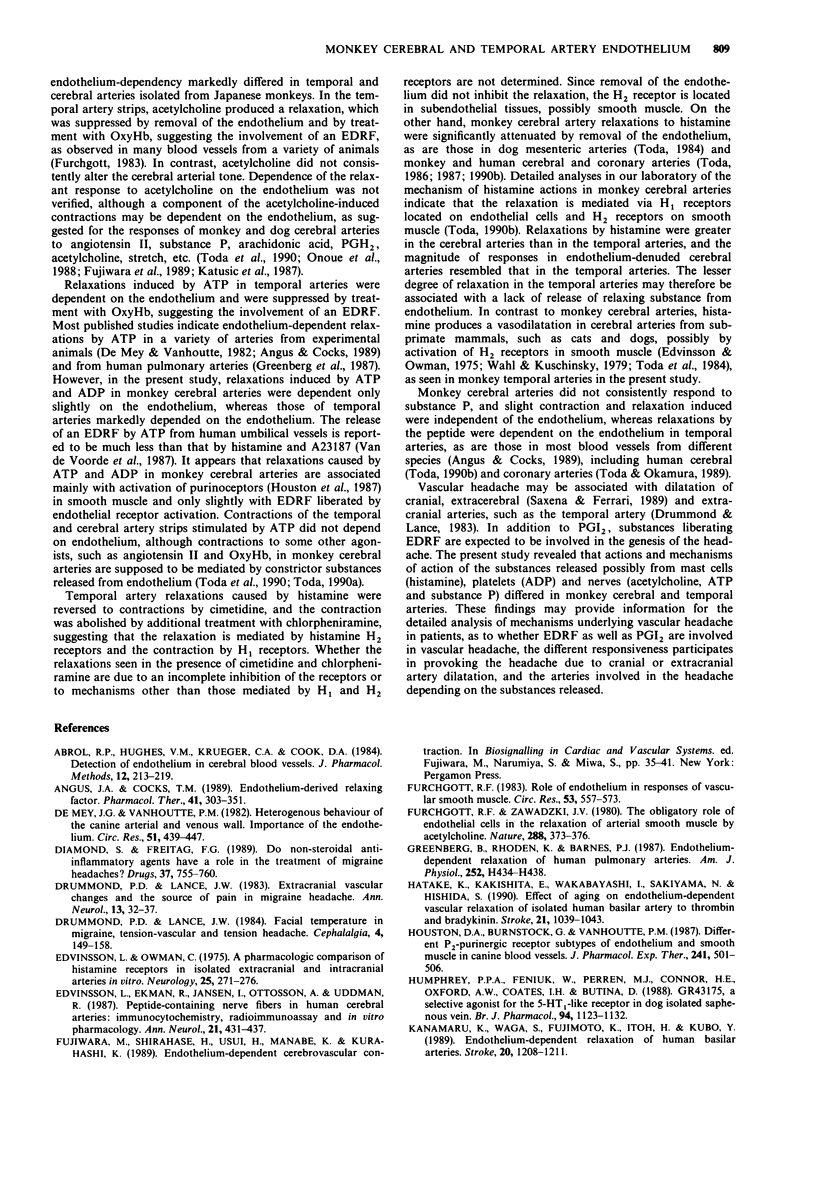
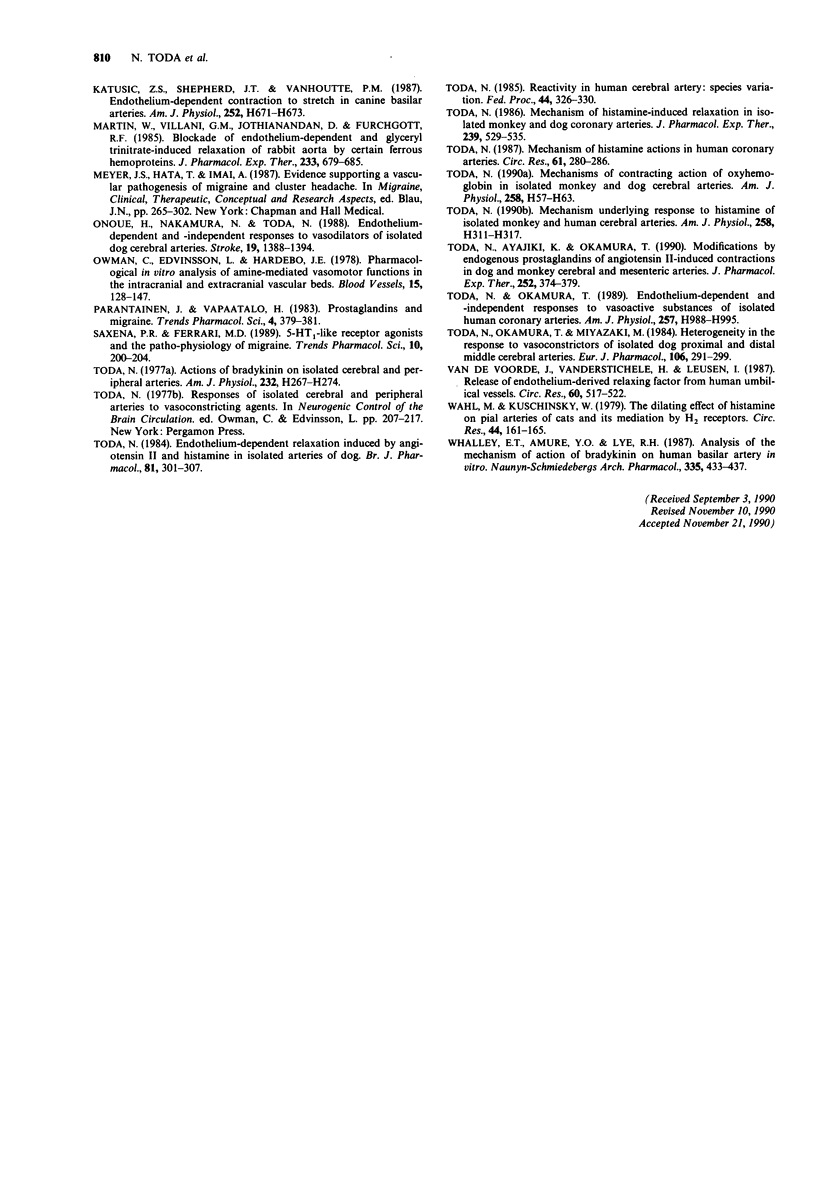
Selected References
These references are in PubMed. This may not be the complete list of references from this article.
- Abrol R. P., Hughes V. M., Krueger C. A., Cook D. A. Detection of endothelium in cerebral blood vessels. J Pharmacol Methods. 1984 Oct;12(3):213–219. doi: 10.1016/0160-5402(84)90062-7. [DOI] [PubMed] [Google Scholar]
- Angus J. A., Cocks T. M. Endothelium-derived relaxing factor. Pharmacol Ther. 1989;41(1-2):303–352. doi: 10.1016/0163-7258(89)90112-5. [DOI] [PubMed] [Google Scholar]
- De Mey J. G., Vanhoutte P. M. Heterogeneous behavior of the canine arterial and venous wall. Importance of the endothelium. Circ Res. 1982 Oct;51(4):439–447. doi: 10.1161/01.res.51.4.439. [DOI] [PubMed] [Google Scholar]
- Diamond S., Freitag F. G. Do non-steroidal anti-inflammatory agents have a role in the treatment of migraine headaches? Drugs. 1989 Jun;37(6):755–760. doi: 10.2165/00003495-198937060-00001. [DOI] [PubMed] [Google Scholar]
- Drummond P. D., Lance J. W. Extracranial vascular changes and the source of pain in migraine headache. Ann Neurol. 1983 Jan;13(1):32–37. doi: 10.1002/ana.410130108. [DOI] [PubMed] [Google Scholar]
- Drummond P. D., Lance J. W. Facial temperature in migraine, tension-vascular and tension headache. Cephalalgia. 1984 Sep;4(3):149–158. doi: 10.1046/j.1468-2982.1984.0403149.x. [DOI] [PubMed] [Google Scholar]
- Edvinsson L., Ekman R., Jansen I., Ottosson A., Uddman R. Peptide-containing nerve fibers in human cerebral arteries: immunocytochemistry, radioimmunoassay, and in vitro pharmacology. Ann Neurol. 1987 May;21(5):431–437. doi: 10.1002/ana.410210503. [DOI] [PubMed] [Google Scholar]
- Edvinsson L., Owman C. A pharmacologic comparison of histamine receptors in isolated extracranial and intracranial arteries in vitro. Neurology. 1975 Mar;25(3):271–276. doi: 10.1212/wnl.25.3.271. [DOI] [PubMed] [Google Scholar]
- Furchgott R. F. Role of endothelium in responses of vascular smooth muscle. Circ Res. 1983 Nov;53(5):557–573. doi: 10.1161/01.res.53.5.557. [DOI] [PubMed] [Google Scholar]
- Furchgott R. F., Zawadzki J. V. The obligatory role of endothelial cells in the relaxation of arterial smooth muscle by acetylcholine. Nature. 1980 Nov 27;288(5789):373–376. doi: 10.1038/288373a0. [DOI] [PubMed] [Google Scholar]
- Greenberg B., Rhoden K., Barnes P. J. Endothelium-dependent relaxation of human pulmonary arteries. Am J Physiol. 1987 Feb;252(2 Pt 2):H434–H438. doi: 10.1152/ajpheart.1987.252.2.H434. [DOI] [PubMed] [Google Scholar]
- Hatake K., Kakishita E., Wakabayashi I., Sakiyama N., Hishida S. Effect of aging on endothelium-dependent vascular relaxation of isolated human basilar artery to thrombin and bradykinin. Stroke. 1990 Jul;21(7):1039–1043. doi: 10.1161/01.str.21.7.1039. [DOI] [PubMed] [Google Scholar]
- Houston D. A., Burnstock G., Vanhoutte P. M. Different P2-purinergic receptor subtypes of endothelium and smooth muscle in canine blood vessels. J Pharmacol Exp Ther. 1987 May;241(2):501–506. [PubMed] [Google Scholar]
- Humphrey P. P., Feniuk W., Perren M. J., Connor H. E., Oxford A. W., Coates L. H., Butina D. GR43175, a selective agonist for the 5-HT1-like receptor in dog isolated saphenous vein. Br J Pharmacol. 1988 Aug;94(4):1123–1132. doi: 10.1111/j.1476-5381.1988.tb11630.x. [DOI] [PMC free article] [PubMed] [Google Scholar]
- Kanamaru K., Waga S., Fujimoto K., Itoh H., Kubo Y. Endothelium-dependent relaxation of human basilar arteries. Stroke. 1989 Sep;20(9):1208–1211. doi: 10.1161/01.str.20.9.1208. [DOI] [PubMed] [Google Scholar]
- Katusic Z. S., Shepherd J. T., Vanhoutte P. M. Endothelium-dependent contraction to stretch in canine basilar arteries. Am J Physiol. 1987 Mar;252(3 Pt 2):H671–H673. doi: 10.1152/ajpheart.1987.252.3.H671. [DOI] [PubMed] [Google Scholar]
- Martin W., Villani G. M., Jothianandan D., Furchgott R. F. Blockade of endothelium-dependent and glyceryl trinitrate-induced relaxation of rabbit aorta by certain ferrous hemoproteins. J Pharmacol Exp Ther. 1985 Jun;233(3):679–685. [PubMed] [Google Scholar]
- Onoue H., Nakamura N., Toda N. Endothelium-dependent and -independent responses to vasodilators of isolated dog cerebral arteries. Stroke. 1988 Nov;19(11):1388–1394. doi: 10.1161/01.str.19.11.1388. [DOI] [PubMed] [Google Scholar]
- Owman C., Edvinsson L., Hardebo J. E. Pharmacological in vitro analysis of amine-mediated vasomotor functions in the intracranial and extracranial vascular beds. Blood Vessels. 1978;15(1-3):128–147. doi: 10.1159/000158159. [DOI] [PubMed] [Google Scholar]
- Saxena P. R., Ferrari M. D. 5-HT(1)-like receptor agonists and the pathophysiology of migraine. Trends Pharmacol Sci. 1989 May;10(5):200–204. doi: 10.1016/0165-6147(89)90238-1. [DOI] [PubMed] [Google Scholar]
- Toda N. Actions of bradykinin on isolated cerebral and peripheral arteries. Am J Physiol. 1977 Mar;232(3):H267–H274. doi: 10.1152/ajpheart.1977.232.3.H267. [DOI] [PubMed] [Google Scholar]
- Toda N., Ayaziki K., Okamura T. Modifications by endogenous prostaglandins of angiotensin II-induced contractions in dog and monkey cerebral and mesenteric arteries. J Pharmacol Exp Ther. 1990 Jan;252(1):374–379. [PubMed] [Google Scholar]
- Toda N. Endothelium-dependent relaxation induced by angiotensin II and histamine in isolated arteries of dog. Br J Pharmacol. 1984 Feb;81(2):301–307. doi: 10.1111/j.1476-5381.1984.tb10079.x. [DOI] [PMC free article] [PubMed] [Google Scholar]
- Toda N. Mechanism of histamine actions in human coronary arteries. Circ Res. 1987 Aug;61(2):280–286. doi: 10.1161/01.res.61.2.280. [DOI] [PubMed] [Google Scholar]
- Toda N. Mechanism underlying responses to histamine of isolated monkey and human cerebral arteries. Am J Physiol. 1990 Feb;258(2 Pt 2):H311–H317. doi: 10.1152/ajpheart.1990.258.2.H311. [DOI] [PubMed] [Google Scholar]
- Toda N. Mechanisms of contracting action of oxyhemoglobin in isolated monkey and dog cerebral arteries. Am J Physiol. 1990 Jan;258(1 Pt 2):H57–H63. doi: 10.1152/ajpheart.1990.258.1.H57. [DOI] [PubMed] [Google Scholar]
- Toda N. Mechanisms of histamine-induced relaxation in isolated monkey and dog coronary arteries. J Pharmacol Exp Ther. 1986 Nov;239(2):529–535. [PubMed] [Google Scholar]
- Toda N., Okamura T. Endothelium-dependent and -independent responses to vasoactive substances of isolated human coronary arteries. Am J Physiol. 1989 Sep;257(3 Pt 2):H988–H995. doi: 10.1152/ajpheart.1989.257.3.H988. [DOI] [PubMed] [Google Scholar]
- Toda N., Okamura T., Miyazaki M. Heterogeneity in the response to vasoconstrictors of isolated dog proximal and distal middle cerebral arteries. Eur J Pharmacol. 1984 Nov 13;106(2):291–299. doi: 10.1016/0014-2999(84)90716-7. [DOI] [PubMed] [Google Scholar]
- Toda N. Reactivity in human cerebral artery: species variation. Fed Proc. 1985 Feb;44(2):326–330. [PubMed] [Google Scholar]
- Van de Voorde J., Vanderstichele H., Leusen I. Release of endothelium-derived relaxing factor from human umbilical vessels. Circ Res. 1987 Apr;60(4):517–522. doi: 10.1161/01.res.60.4.517. [DOI] [PubMed] [Google Scholar]
- Wahl M., Kuschinsky W. The dilating effect of histamine on pial arteries of cats and its mediation by H2 receptors. Circ Res. 1979 Feb;44(2):161–165. doi: 10.1161/01.res.44.2.161. [DOI] [PubMed] [Google Scholar]
- Whalley E. T., Amure Y. O., Lye R. H. Analysis of the mechanism of action of bradykinin on human basilar artery in vitro. Naunyn Schmiedebergs Arch Pharmacol. 1987 Apr;335(4):433–437. doi: 10.1007/BF00165559. [DOI] [PubMed] [Google Scholar]


